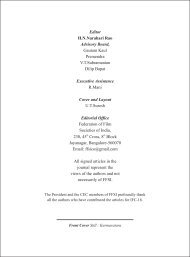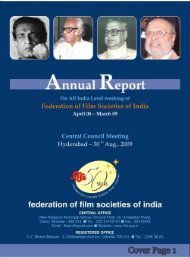Indian Film Culture.P65 - federation of film societies of india
Indian Film Culture.P65 - federation of film societies of india
Indian Film Culture.P65 - federation of film societies of india
Create successful ePaper yourself
Turn your PDF publications into a flip-book with our unique Google optimized e-Paper software.
organising <strong>film</strong> appreciation and academic activities<br />
simultaneously.<br />
The downward slide <strong>of</strong> the movement continued for the<br />
almost 10 years — from 1984 to 1994. However, in 1992,<br />
Hollywood took note <strong>of</strong> Satyajit Ray’s contribution to<br />
cinema, and honoured an unwell Ray with a Special Oscar<br />
for lifetime achievement. Ray was hospitalized at that time,<br />
and soon passed away. However, the Oscar created a buzz<br />
about the legend and his cinema, and generated fresh<br />
enthusiasm in the movement. It created a curiosity about<br />
the movement among lay cinegoers.<br />
In 1991, India adopted market economy, and joined the<br />
globalization bandwagon. Globalisation opened up the skies<br />
and satellite television followed cable television into India.<br />
It also brought a slew <strong>of</strong> television channels, and killed the<br />
video craze. In 1995 when cinema celebrated its centenary,<br />
DVD and CD technology was introduced in India. If the<br />
video technology hit the <strong>Film</strong> Society Movement, the DVD<br />
technology rejuvenated it, and put life back into it. The<br />
FFSI sniffed a good opportunity to revive the movement<br />
with easy availability <strong>of</strong> <strong>film</strong>s on DVD.<br />
The 7 th Triennial conference held in Pune discussed the<br />
possibility <strong>of</strong> adopting the DVD format in the <strong>film</strong> society<br />
screenings. Foreign embassies and consulates informed the<br />
FFSI that henceforth they will not bring in 35 or 16 mm<br />
<strong>film</strong>s, but only DVDs <strong>of</strong> the contemporary cinema made in<br />
their respective countries. Since the birth <strong>of</strong> the movement,<br />
the FFSI had relied heavily on foreign <strong>film</strong>s supplied by<br />
foreign missions <strong>of</strong> various countries. With this change,<br />
<strong>film</strong> <strong>societies</strong> gradually began showing <strong>film</strong>s on DVD, and<br />
it triggered a revival <strong>of</strong> the movement. After year 2000,<br />
new <strong>film</strong> <strong>societies</strong> began coming up. Some <strong>of</strong> the closed<br />
<strong>societies</strong> began reviving, and the membership strength <strong>of</strong><br />
each society began improving.<br />
In 2006 the Central Office <strong>of</strong> the FFSI shifted to Mumbai.<br />
Shyam Benegal was President and I was elected as a<br />
General Secretary. We conducted a survey <strong>of</strong> the<br />
memberships <strong>of</strong> <strong>film</strong> <strong>societies</strong> and found that the average<br />
age <strong>of</strong> <strong>film</strong> society member was between 40 & 45 years. It<br />
meant that youngsters between the age group <strong>of</strong> 18 & 25<br />
years were fewer in numbers. Benegal then gave a call for<br />
forming ‘Campus <strong>Film</strong> <strong>societies</strong>’ in Colleges and<br />
Universities. Accordingly, the West and South Region made<br />
the first efforts in this direction and Campus <strong>Film</strong> Societies<br />
began coming up.<br />
In 2008-09, the FFSI decided to celebrate its Golden Jubilee<br />
(1959 – 2009) in a big way. The purpose <strong>of</strong> the grand<br />
August 2010 / <strong>Indian</strong> <strong>Film</strong> <strong>Culture</strong> 8<br />
celebrations was to reach out to people outside the <strong>film</strong><br />
society circuit. We also noticed that the National <strong>Film</strong><br />
Archive <strong>of</strong> India had been organising <strong>film</strong> appreciation<br />
courses in English since 1967. Realising that <strong>film</strong> culture<br />
could not be spread only in a foreign language, the FFSI<br />
decided to organise <strong>film</strong> appreciation courses in local<br />
languages to reach out to cinegoers.<br />
The Maharashtra Chapter <strong>of</strong> the FFSI took the initiative<br />
and organised the first Regional language <strong>Film</strong> Appreciation<br />
Course (Marathi) at Pune in collaboration with Pune<br />
University in 2007. The National <strong>Film</strong> Archive <strong>of</strong> India<br />
also joined hands, and from 2010 the FFSI and NFAI will<br />
jointly organise F.A. Courses in Regional languages. Four<br />
F A Courses are in the pipeline in Hindi (Indore) Kannada<br />
(Bangalore) Telugu (Karim Nagar) and Marathi (Pune). It<br />
is expected that these language courses will take the<br />
movement beyond big metro cities and will also help<br />
impress upon <strong>film</strong> <strong>societies</strong> that they should lay a special<br />
emphasis on academic activities along with <strong>film</strong> screening.<br />
Activities like discussions on <strong>film</strong>s screened, short <strong>film</strong><br />
appreciation courses, seminars could be organised. And this<br />
has become possible due to the DVD technology.<br />
Critics <strong>of</strong> the movement <strong>of</strong>ten ask me what is the relevance<br />
<strong>of</strong> the <strong>Film</strong> Society Movement today when three 24-hour<br />
TV channels beam world cinema into satellite homes?<br />
Moreover, they say, DVDs <strong>of</strong> world cinema can be accessed<br />
by a lay cinegoer at the neighbourhood DVD library. On<br />
the face <strong>of</strong> it, this argument looks absolutely right. However,<br />
the fact is that even bad cinema has reached our homes.<br />
Not all <strong>film</strong>s screened by the TV channels are classics <strong>of</strong><br />
cinema. I feel that it is because <strong>of</strong> this that the <strong>Film</strong> Society<br />
Movement remains even more relevant today.<br />
World literature is available in book shops as well prominent<br />
libraries in a city like Mumbai. Yet why do colleges and<br />
universities teach literature in classrooms? It is to establish<br />
the nuances and create a deeper understanding <strong>of</strong> global<br />
literature. I, therefore, feel that doubts about the relevance<br />
<strong>of</strong> <strong>Film</strong> Society Movement’s should be a closed subject<br />
henceforth. <strong>Film</strong> society activists who work so selflessly,<br />
without any recognition or remuneration, should continue<br />
to work towards achieving the goal <strong>of</strong> disseminating <strong>film</strong><br />
culture.<br />
To celebrate its Golden Jubilee, the FFSI has, in<br />
collaboration with Asian <strong>Film</strong> Foundation, published a<br />
book, History <strong>of</strong> <strong>Film</strong> Society Movement edited by H N<br />
Narahari Rao. The book records with great care the rise<br />
and fall and the revival <strong>of</strong> the movement. More such books<br />
should be published in regional languages to reach out to a





